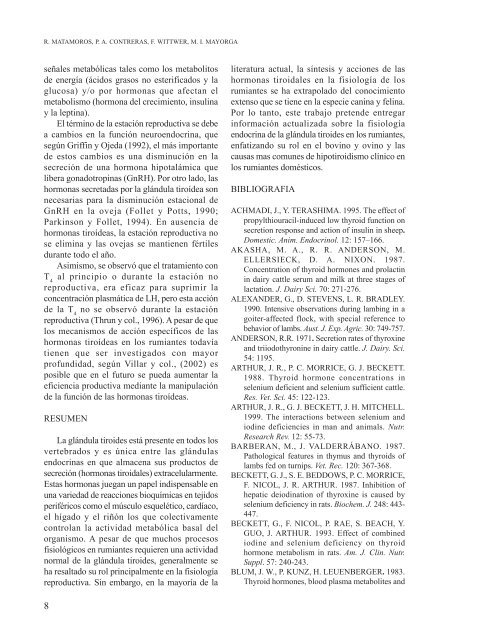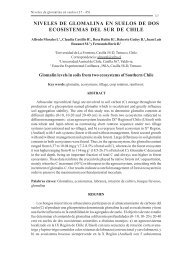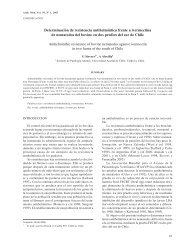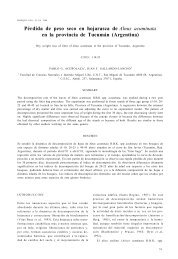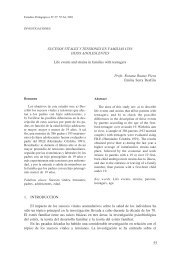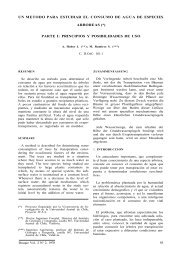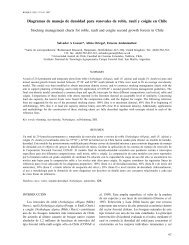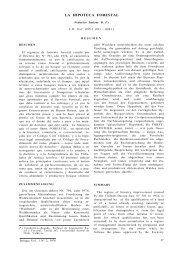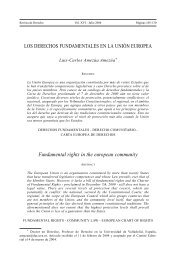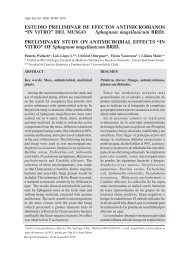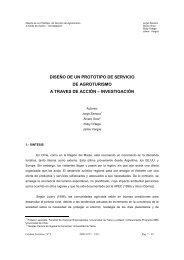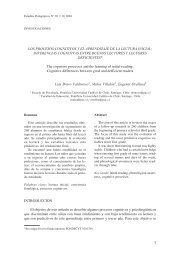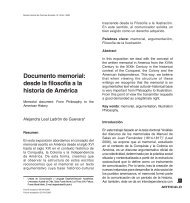Hipotiroidismo en rumiantes - Universidad Austral de Chile
Hipotiroidismo en rumiantes - Universidad Austral de Chile
Hipotiroidismo en rumiantes - Universidad Austral de Chile
You also want an ePaper? Increase the reach of your titles
YUMPU automatically turns print PDFs into web optimized ePapers that Google loves.
R. MATAMOROS, P. A. CONTRERAS, F. WITTWER, M. I. MAYORGA<br />
señales metabólicas tales como los metabolitos<br />
<strong>de</strong> <strong>en</strong>ergía (ácidos grasos no esterificados y la<br />
glucosa) y/o por hormonas que afectan el<br />
metabolismo (hormona <strong>de</strong>l crecimi<strong>en</strong>to, insulina<br />
y la leptina).<br />
El término <strong>de</strong> la estación reproductiva se <strong>de</strong>be<br />
a cambios <strong>en</strong> la función neuro<strong>en</strong>docrina, que<br />
según Griffin y Ojeda (1992), el más importante<br />
<strong>de</strong> estos cambios es una disminución <strong>en</strong> la<br />
secreción <strong>de</strong> una hormona hipotalámica que<br />
libera gonadotropinas (GnRH). Por otro lado, las<br />
hormonas secretadas por la glándula tiroí<strong>de</strong>a son<br />
necesarias para la disminución estacional <strong>de</strong><br />
GnRH <strong>en</strong> la oveja (Follet y Potts, 1990;<br />
Parkinson y Follet, 1994). En aus<strong>en</strong>cia <strong>de</strong><br />
hormonas tiroí<strong>de</strong>as, la estación reproductiva no<br />
se elimina y las ovejas se manti<strong>en</strong><strong>en</strong> fértiles<br />
durante todo el año.<br />
Asimismo, se observó que el tratami<strong>en</strong>to con<br />
T al principio o durante la estación no<br />
4<br />
reproductiva, era eficaz para suprimir la<br />
conc<strong>en</strong>tración plasmática <strong>de</strong> LH, pero esta acción<br />
<strong>de</strong> la T no se observó durante la estación<br />
4<br />
reproductiva (Thrun y col., 1996). A pesar <strong>de</strong> que<br />
los mecanismos <strong>de</strong> acción específicos <strong>de</strong> las<br />
hormonas tiroí<strong>de</strong>as <strong>en</strong> los <strong>rumiantes</strong> todavía<br />
ti<strong>en</strong><strong>en</strong> que ser investigados con mayor<br />
profundidad, según Villar y col., (2002) es<br />
posible que <strong>en</strong> el futuro se pueda aum<strong>en</strong>tar la<br />
efici<strong>en</strong>cia productiva mediante la manipulación<br />
<strong>de</strong> la función <strong>de</strong> las hormonas tiroí<strong>de</strong>as.<br />
RESUMEN<br />
La glándula tiroi<strong>de</strong>s está pres<strong>en</strong>te <strong>en</strong> todos los<br />
vertebrados y es única <strong>en</strong>tre las glándulas<br />
<strong>en</strong>docrinas <strong>en</strong> que almac<strong>en</strong>a sus productos <strong>de</strong><br />
secreción (hormonas tiroidales) extracelularm<strong>en</strong>te.<br />
Estas hormonas juegan un papel indisp<strong>en</strong>sable <strong>en</strong><br />
una variedad <strong>de</strong> reacciones bioquímicas <strong>en</strong> tejidos<br />
periféricos como el músculo esquelético, cardíaco,<br />
el hígado y el riñón los que colectivam<strong>en</strong>te<br />
controlan la actividad metabólica basal <strong>de</strong>l<br />
organismo. A pesar <strong>de</strong> que muchos procesos<br />
fisiológicos <strong>en</strong> <strong>rumiantes</strong> requier<strong>en</strong> una actividad<br />
normal <strong>de</strong> la glándula tiroi<strong>de</strong>s, g<strong>en</strong>eralm<strong>en</strong>te se<br />
ha resaltado su rol principalm<strong>en</strong>te <strong>en</strong> la fisiología<br />
reproductiva. Sin embargo, <strong>en</strong> la mayoría <strong>de</strong> la<br />
8<br />
literatura actual, la síntesis y acciones <strong>de</strong> las<br />
hormonas tiroidales <strong>en</strong> la fisiología <strong>de</strong> los<br />
<strong>rumiantes</strong> se ha extrapolado <strong>de</strong>l conocimi<strong>en</strong>to<br />
ext<strong>en</strong>so que se ti<strong>en</strong>e <strong>en</strong> la especie canina y felina.<br />
Por lo tanto, este trabajo pret<strong>en</strong><strong>de</strong> <strong>en</strong>tregar<br />
información actualizada sobre la fisiología<br />
<strong>en</strong>docrina <strong>de</strong> la glándula tiroi<strong>de</strong>s <strong>en</strong> los <strong>rumiantes</strong>,<br />
<strong>en</strong>fatizando su rol <strong>en</strong> el bovino y ovino y las<br />
causas mas comunes <strong>de</strong> hipotiroidismo clínico <strong>en</strong><br />
los <strong>rumiantes</strong> domésticos.<br />
BIBLIOGRAFIA<br />
ACHMADI, J., Y. TERASHIMA. 1995. The effect of<br />
propylthiouracil-induced low thyroid function on<br />
secretion response and action of insulin in sheep.<br />
Domestic. Anim. Endocrinol. 12: 157–166.<br />
AKASHA, M. A., R. R. ANDERSON, M.<br />
ELLERSIECK, D. A. NIXON. 1987.<br />
Conc<strong>en</strong>tration of thyroid hormones and prolactin<br />
in dairy cattle serum and milk at three stages of<br />
lactation. J. Dairy Sci. 70: 271-276.<br />
ALEXANDER, G., D. STEVENS, L. R. BRADLEY.<br />
1990. Int<strong>en</strong>sive observations during lambing in a<br />
goiter-affected flock, with special refer<strong>en</strong>ce to<br />
behavior of lambs. Aust. J. Exp. Agric. 30: 749-757.<br />
ANDERSON, R.R. 1971. Secretion rates of thyroxine<br />
and triiodothyronine in dairy cattle. J. Dairy. Sci.<br />
54: 1195.<br />
ARTHUR, J. R., P. C. MORRICE, G. J. BECKETT.<br />
1988. Thyroid hormone conc<strong>en</strong>trations in<br />
sel<strong>en</strong>ium <strong>de</strong>fici<strong>en</strong>t and sel<strong>en</strong>ium suffici<strong>en</strong>t cattle.<br />
Res. Vet. Sci. 45: 122-123.<br />
ARTHUR, J. R., G. J. BECKETT, J. H. MITCHELL.<br />
1999. The interactions betwe<strong>en</strong> sel<strong>en</strong>ium and<br />
iodine <strong>de</strong>fici<strong>en</strong>cies in man and animals. Nutr.<br />
Research Rev. 12: 55-73.<br />
BARBERAN, M., J. VALDERRÁBANO. 1987.<br />
Pathological features in thymus and thyroids of<br />
lambs fed on turnips. Vet. Rec. 120: 367-368.<br />
BECKETT, G. J., S. E. BEDDOWS, P. C. MORRICE,<br />
F. NICOL, J. R. ARTHUR. 1987. Inhibition of<br />
hepatic <strong>de</strong>iodination of thyroxine is caused by<br />
sel<strong>en</strong>ium <strong>de</strong>fici<strong>en</strong>cy in rats. Biochem. J. 248: 443<br />
447.<br />
BECKETT, G., F. NICOL, P. RAE, S. BEACH, Y.<br />
GUO, J. ARTHUR. 1993. Effect of combined<br />
iodine and sel<strong>en</strong>ium <strong>de</strong>fici<strong>en</strong>cy on thyroid<br />
hormone metabolism in rats. Am. J. Clin. Nutr.<br />
Suppl. 57: 240-243.<br />
BLUM, J. W., P. KUNZ, H. LEUENBERGER. 1983.<br />
Thyroid hormones, blood plasma metabolites and


